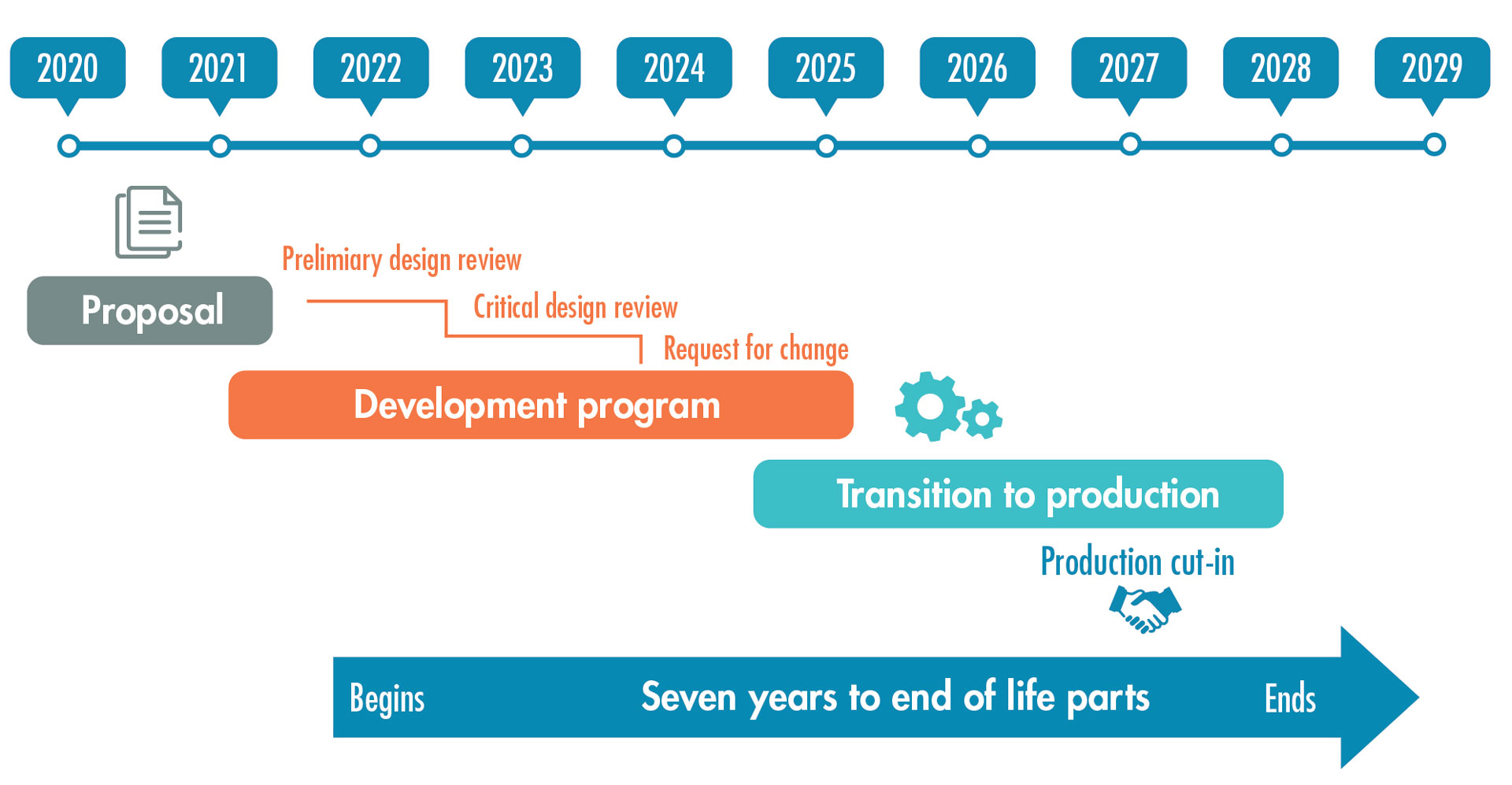
OBSOLESCENCE IN PRACTICE: It’s an all-too-familiar scenario for many. When purchasing a new cellphone, you may find yourself also needing a new charger, new earbuds and a new case. The old ones still worked fine, but they are not compatible with the new phone. (Image by GettyImages)
Lessons learned from an assistant product manager.
by Maj. Megan M. Evans
“Why does this have to be so complicated?”
That is the question I asked during my first quarterly review, where we examined parts and materiel that were at risk of becoming obsolete. I was the assistant product manager for the Patriot Advanced Capability – Phase 3 Missile Segment Enhancement (PAC-3 MSE) Missile, the most recent variant in the Patriot family of air defense artillery missiles. That simple question led me into a review and subsequent analysis detailing obsolescence issues specific to the missile that turned out to be much more complex than anticipated. I started with questions, more questions, and then thankfully some answers that enabled discussions on where the MSE design should go to help manage the risk of obsolescence.
THE ISSUE
Obsolescence is both a challenge and an opportunity. When someone thinks of a part becoming obsolete, typically they think of older parts that become outmoded and replaced over time—like rotary phones, for example. For the Patriot missile, however, the meaning of “obsolete” is more complex than that. It’s not just the part itself, but the part’s impact on the larger system.
Take your cellphone, for example. After several years, the manufacturer will no longer support your phone with software updates. You purchase a new phone, but then realize it is not compatible with your old charger, your earbuds and other components. You only needed a new phone, but now you have to replace all of those subcomponents in order to keep the same functionality. You have just lived through obsolescence, and are probably a lot lighter in the wallet.
The same is true when a weapon system’s part becomes obsolete after the system is already developed or produced. When parts for a subcomponent of a missile become obsolete, that drives redesigns. Still, opportunities emerge when program offices can balance and control obsolescence and its redesigns to strategically increase performance characteristics in a system and keep it competitive against emerging threats.

SO MANY QUESTIONS: Evans encourages other assistant product managers to ask as many questions as necessary while becoming familiar with their new roles. (Image by GettyImages)
HOW COULD THIS EVEN HAPPEN?
When the PAC-3 MSE was first delivered in 2014, the contract called for 92 missiles per year. Demand increased steadily as international partners began procuring systems of their own through foreign military sales (FMS); most recently increasing to 500 per year for the 2022 fiscal year.
MSE major redesigns typically occur about every four years. These redesigns are planned to allow the technology to evolve over time, and they are useful to address technology that becomes obsolete. But redesigns are expensive. For the MSE, a large portion of the costs were shared with FMS partners through an international engineering service program contract.
This faster obsolescence phenomenon is caused, in large part, by the increase in annual production requirements to meet worldwide demand versus planned production in the original obsolescence plans. That’s because a prime contractor bought enough parts for the original contracted numbers, but when the requirement increased because of factors like FMS demand, the parts ran out faster than projected. When the contractor ordered new parts to increase production, some of the parts were no longer available, driving the need for a redesign. If the contractor did not complete a redesign to account for those unavailable parts, there would be gaps in production. Surprisingly, the U.S. government still has to pay personnel- or maintenance-associated costs for production lines, even if they go cold, as part of the contracts to maintain the lines’ functionality while issues are resolved.
Commercial parts purchased for the MSE are a small portion of the overall commercial market share. Major components within these missiles actually use parts that are similar to those in cellphones—just made with military specifications. DOD is not a major buyer of the type of commercial parts and materiel that our prime contractor uses for designs, such as processors and memory (approximately 1 percent of commercial market share). The U.S. and its FMS partners buy parts and materiel for hundreds of missiles annually.
In contrast, commercial companies like cellphone makers purchase parts for millions of products per year. Cellphone companies are always adapting to the desires of consumers, and consequently, larger subcomponent providers adapt and evolve for large primes because of their share of the market. As a hypothetical example, a subcomponent provider might stop making certain parts, like a processor used by the U.S. government in a particular missile seeker, and shift its efforts to meet other lucrative market demands, like a more advanced processor for my phone so I can stream videos of fainting goats.
WHY DON’T WE JUST BUY MORE PARTS?
One way to mitigate this kind of situation is for the U.S. government and prime contractors to execute a lifetime buy of the discontinued part. A lifetime buy is based on an estimate of the number of parts that would be needed, due to contractual requirements and expected number of missiles.
Changing demands heavily affect the long-term viability of those lifetime buys, however. As the MSE demand increased per year, the lifetime buy run-out point came earlier than originally estimated. These changes accelerate the need to redesign sooner than originally planned.
In most instances, contractors will not buy components ahead of need for production until the development and qualification programs are complete. Business strategies motivate contractors to look at the tradeoff between ordering parts too early, the expense of building adequate facilities for storage, and the risk of excess inventory, versus not ordering parts soon enough, which impacts production schedules. By law, the government cannot buy parts ahead of need, and must procure parts for requirements each year within the president’s budget. So, even in face of obsolescence, a possible redesign, and knowing that buying more parts now will mitigate risk to the production line by “buying in bulk” with a lifetime buy, you do not have the authority by law, nor the money to do it. Interesting, right?
In MSE, design specifications are planned to maintain the same interface from the preliminary design review through seven years, until the design becomes obsolete. (See Figure below) This seven-year figure is based on the term YTEOL, or Years to End of Life. The preliminary design review usually happens six to 18 months into development, and is followed by a critical design review, and then a request for change. Once the design reaches production, there is only a small window of time remaining before the design becomes obsolete. Another surprise to this young assistant product manager!

OBSOLETE BY DESIGN: Design specifications are planned to maintain the same interface from the preliminary design review for a seven-year period, until the design becomes obsolete. (Graphic by the author)
HOW CAN WE FIX THIS?
The PAC-3 MSE product office implemented a long-range, strategic planning cell that built a product road map to show where the missile technology needs to be inserted to support the requirements. The product road map helps strategize and control timing of redesigns, while taking the opportunity to add performance improvements. The planning cell facilitates crucial conversations with contractors, causing them to think differently about which part manufacturers they utilize for designs. The contractor builds a design and chooses parts based on a list of weighted criteria, including required speeds, weight, distance, targets to engage, and somewhere down on the list, risk of obsolescence.
For example, remember that commercial processor that allows me to watch fainting goats on my cellphone? It could also be chosen for the contractor’s design because it gives the missile seeker required performance. However, that processor may have a high risk of obsolescence, which would push it further down on our weighted selection scale. We also evaluate providers in other industries, such as the auto industry. Analysis must be conducted to see if these parts could be utilized and have more longevity, providing greater production stability. As DOD continues its modernization efforts, and pivots toward using artificial intelligence in operations, understanding how these single-source unique parts affect the longevity of a weapon’s design and production will be crucial. Therefore, the government and the contractor need to have that crucial conversation prior to and at preliminary design review about which part is in the final design. If not, it could have a waterfall effect when that advanced processor needs to be replaced sooner than planned and forces the system to be modified.
As described earlier, business strategies drive contractors’ decisions to invest in parts ahead of need. However, those factors do not drive the government. Laws governing acquisitions limit the government’s ability to commit funds ahead of need, but there are tools that can help and acquisition strategies it can employ to reduce risk.
Multi-year contracts could help fund requirements in future production years to keep enough parts on hand to mitigate production obsolescence risks. According to the Navy Multi-Year Procurement Guidebook, the U.S. Navy has used these types of contracts to lower costs, provide substantial continuity of production or performance of its procurements, and provide incentives to contractors to improve productivity through investment in capital facilities. Another innovative idea is to rethink how the U.S. and its FMS partners quantify the amount of parts purchased during the development contract and transition to production. Additional parts purchased at that time could be a risk mitigation tool to protect against more parts being used than originally projected.

EYES ON THE PRIZE: As a new assistant product manager, Evans discovered how little she knew about obsolescence, among other complex ideas in acquisition. To make judicious use of taxpayer dollars, she said it is imperative to wade through the issues and associated mitigation techniques. (Image by GettyImages)
THE WAY AHEAD
Obsolescence is complex, and using lessons learned from other programs is a good place to start when going into any new development program.
Building out a product road map to see where the design will go over the years to meet objective requirements helps manage the risk of obsolescence. As the U.S. implements its road maps during design or redesign, risk of obsolescence should not be an under-valued criterion. Finding new suppliers for sole-source unique parts (specialized ones that are not easily replaced) is another way to manage obsolescence risk. Using “new” contracting methods like multi-year contracts, even if they are not typical to your product office or system, is another way to support a more strategic approach to managing production.
The warfighter and FMS partners count on stable production for protection against current and emerging threats around the world as they execute multidomain operations. Equally important, acquisition professionals have a responsibility to U.S. taxpayers to ensure we optimize our investments of their resources. DOD is operating in a resource-constrained environment, so finding innovative ways to save funding over time is crucial.
I implore assistant product managers, especially other “newbies,” to keep asking questions, no matter how simple or silly you think you may sound. Like the great philosopher Socrates, your curiosity and probing questions may break through some of the complexities and find solutions. You must become well-versed in your programs and use critical thinking to enable the learning process.
For more information, contact the author at megan.m.pekolevans.mil@mail.mil.
MAJ. MEGAN M. EVANS is the assistant product manager for the Next Generation Squad Weapon in PEO Soldier Her.first acquisition assignment was in the Program Executive Office for Missiles and Space in Huntsville, Alabama, as the assistant product manager for PAC-3 Missile Segment Enhancement, from November 2019 until June 2020. She then served as the Precision Strike Missile assistant product manager. She holds an MBA from Trident University and a B.S. in administration of justice from Penn State University, where she was commissioned as an air defense artillery officer through the ROTC. She deployed to Afghanistan in support of Operation Enduring Freedom with the 3rd Special Forces Group (A) as the team leader for Cultural Support Team-54.







